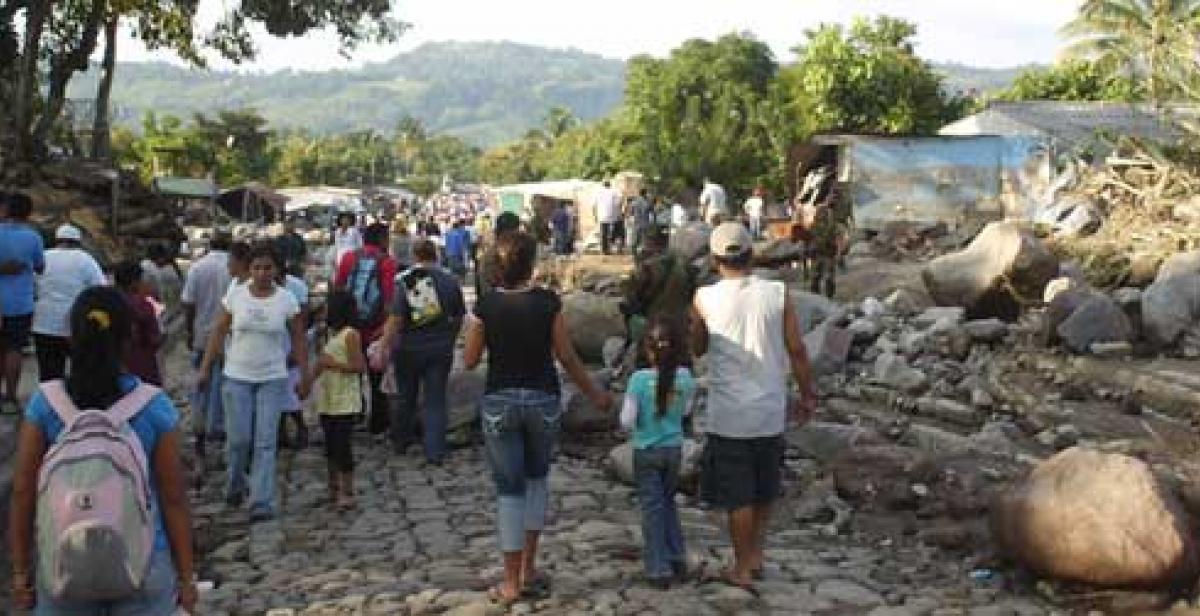I am constantly learning here in El Salvador, but one lesson that continues to impact me is what happens when it rains hard. Where I come from in the US, a rainy day is an excuse to settle in at home, watch movies, be lazy, and eat comfort food.
But I remember when Hurricane Ida hit El Salvador the weekend of November 7th and 8th, 2009, that that was exactly what I did here. I phoned people I know that lived in champas (shacks) to see how badly they were hit, and they said they were surviving. But one Sunday, I got a call from my co-worker Carlos who had gone home to the Verapaz region in San Miguel to visit his family for the weekend. His voice sounded strange, but he had only rung to ask for the number of another co-worker, so I just gave it to him and settled in to listen to the rain pound outside.
After my lazy weekend, I trudged through the rain to work at Progressio partner UNES on Monday morning. It was then that I realized how bad things had been over the weekend. Many of my colleagues were not at work. Later, in an emergency meeting, I discovered that they were in the various parts of the country where they work, trying to assess damages and deliver material aid to shelters.
At the end of it all, authorities calculated 200 deaths, 77 people missing, close to 8,000 people in shelters, and long term damage to crops and infrastructure throughout the country. The most horrifying impact of the storm was a landslide on the side of the Volcano San Miguel, which carried tons of dirt and rocks into the Verapaz region at the foot of the volcano. That is where Carlos had been that night when the landslide hit. He had rescued his mother and three year old nephew from the neck-deep mud that filled his house. His car was buried under a metre of mud, and every weekend for the following months he would return to help dig houses out of the mud, and rebuild the basic infrastructure of the town.
Since the rude awakening Ida gave me, I am more alert and aware of how much rain is falling and listen to the news to learn about who and where the rains are wreaking havoc. This is especially pertinent now, as we are in the rainy season with a forecast of an extremely active season of hurricanes and tropical storms.
After the rains of the tropical storm Agatha in June, I went with UNES co-workers and local reporters to see the damage done to communities in the coastal zone of Ahuachapán, where we work closely with many communities. My heart felt broken when a group of three little boys told me how scary it was when the water came up to their chests.
I am not sharing this to generate sympathy for the people of El Salvador, but more to highlight the how intensely delicate and vulnerable a country it is, and how resilient the people are.
But things are getting worse. We can see the impact of climate change here. Weather patterns are more erratic than they were just a few years ago. There's more drought, more heavy, intense and erratic storms, and the sea level is rising - eating away at the precious coastline where many people live and work.
It is a never-ending process understanding how complex histories and current realities have brought us to where we are right now, but it's starting to click for me. I feel like I am weaving an understanding of the connections between the history of repression, poverty, and violence, the vulnerability the majority of the population lives in, and the current climate and water crises the country faces.
The most valuable part of living and working as a Progressio development worker in El Salvador, is the process of personal transformation that comes from witnessing the reality that people live with, and accompanying them in their struggle for justice. Even though we are up against so much, I still feel some hope for this tiny, beautiful country and its people. I think that's the only way we can keep moving forward.
Maggie Von Vogt is a Progressio development worker in El Salvador
Photograph: Local people assess the damage caused by the landslide, Verapaz, San Miguel, November 2009, © Luis González, UNES



